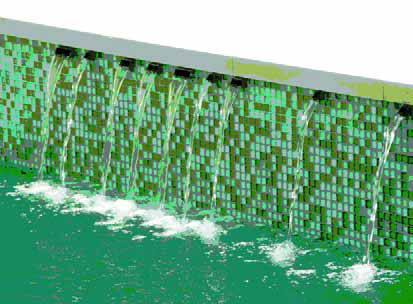visual effects
Elegance, romance, subtlety, tranquility: All these words speak to a potential of watershaping that is realized far too infrequently. If ever there were a common detail that typifies these missed opportunities, I'd have to give the prize to the standard waterfall/waterwall effects seen on too many pools and other watershapes these days. I can think of nothing less compelling than the typical sheet of water spilling down the face of a wall or in front of some other structure on its way into a pool or spa. This look is not only overused, but
When I was a kid in Caltagirone, Sicily, everybody worked hard all the time - grueling manual labor in the fields and factories. By the time I was eight years old, I was already working with my father in a ceramic-sculpture foundry. I didn't do much more than sweep the floors, but I was around all sorts of craftspeople and began to see that there were some forms of hard work that were more fulfilling than others. So I began to think about becoming a painter. I took my first steps in that direction at 13. By the time I was 18, I'd opened a studio and was painting and sculpting on my own. In those days, the arts community was an exciting place where we shared ideas, fed on each others' energy and competed with each other for good commissions. I'm not ashamed to admit that I thought the established artists I hung out with were cool and powerful in their own ways - and that I wanted to be just like them. Given the specific nature of my art, it's not surprising that the great Italian masters heavily influenced my work right from the start, including Michelangelo, Raphael and especially Leonardo Da Vinci. They are my heroes, and I see the work I do as a modest continuation of the traditions they established. These artists taught me that great art is about passion and the desire to
For many of us in the watershaping business, the design and creation of fountains and water displays follows a predictable set of functional patterns. Given the traditional tools of the trade and our repertoire of nozzles and spray apparatus, for example, we tend to fashion effects and shapes from the ground up, literally throwing water in the air in a more or less uncontrolled manner. From a design standpoint, the problem with this tradition is that it eats up space like nobody's business: The pools needed to catch free-falling flows of any noteworthy height need to be large enough to capture water subject to the effects of splash, wind drift and overspray. The higher the spray, the larger must be the footprint of the pool to contain it adequately. As a rule, these pools need to have diameters of twice the height of the spray - by any measure a significant contribution of expensive commercial real estate to the creative effort at a time when property owners are motivated to make every available square foot an income producer. As an alternative in this space race, watershapers have found dry-deck or curbless fountains to be a great way to
Through all the centuries of watershape design, the laws of physics have imposed restrictions on the watershaper's ability to extend a laminar flow of sheeting water beyond a drop of five or six feet. Go much beyond that limit and the sheet breaks up, thus impairing the aesthetic effect, causing an annoying degree of splashing and generating an abundance of undesirable, monotonous noise. Those physical laws have been seriously bent in public spaces in recent times. Indeed, special weirs and nozzles have made it possible to achieve laminar flows of 12 feet or more. Up until now, the solutions employed to achieve these effects have usually been beyond the budget of smaller commercial projects or residential clients - but that's changing. At my firm, Crystal Fountains, we've long been studying the phenomenon of falling water with an eye toward maximizing the surface tension of water and thereby extending the "laminar" effect without breaking the bank. We've had the luxury of working on some high-end projects that enabled us to perform the research and development necessary to do that stretching. By adapting some of the design ideas we
It's an age-old paradox, this relationship between art and science. On the face of it, things artistic may seem solely the realm of high-flying thinkers and philosophers who spend their days at the far reaches of interpretation and meaning. By contrast, engineers and scientists would seem to be dealing purely in the certainties of what is quantifiable and real. The truth is, I don't know of a modern art form that doesn't involve technology of some kind. Conversely, most branches of modern science call upon researchers to apply a great deal of intuition and creativity to the processes of exploration and discovery. In other words, neither the arts nor the sciences could exist without ideas and disciplines derived from the other. That's especially true when it comes to water systems. Whether created for aesthetic or recreational purposes, art and science can come together here in a particularly compelling and interesting way. By combining technical disciplines with
As is the case with a stream's aesthetics, the functionality of any multi-level, gravity-driven waterway must be considered from the outset of any project. After all, no matter how natural and beguiling a stream may be in appearance, if it doesn't hold water, work properly in terms of hydraulics and filtration or provide ecological balance, the whole thing can and will become a nightmare. Fortunately, making streams work isn't all that difficult - as long as you keep your eye on a critical set of fundamentals. Last time, we laid out the stream course, created


















